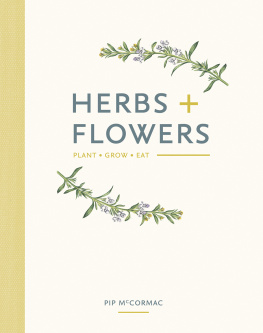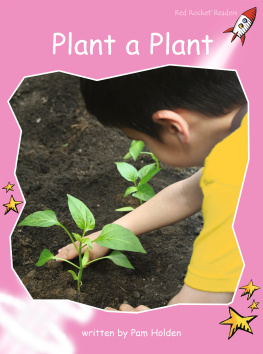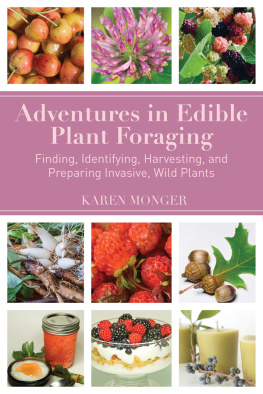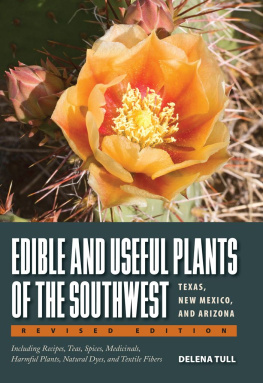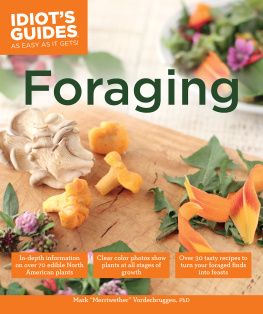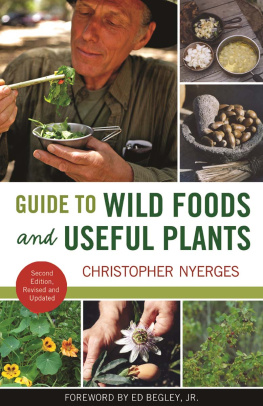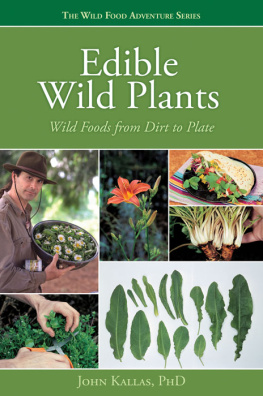Fox Fire Students - Wild Spring Plant Foods
Here you can read online Fox Fire Students - Wild Spring Plant Foods full text of the book (entire story) in english for free. Download pdf and epub, get meaning, cover and reviews about this ebook. year: 2011, publisher: Anchor, genre: Home and family. Description of the work, (preface) as well as reviews are available. Best literature library LitArk.com created for fans of good reading and offers a wide selection of genres:
Romance novel
Science fiction
Adventure
Detective
Science
History
Home and family
Prose
Art
Politics
Computer
Non-fiction
Religion
Business
Children
Humor
Choose a favorite category and find really read worthwhile books. Enjoy immersion in the world of imagination, feel the emotions of the characters or learn something new for yourself, make an fascinating discovery.

- Book:Wild Spring Plant Foods
- Author:
- Publisher:Anchor
- Genre:
- Year:2011
- Rating:3 / 5
- Favourites:Add to favourites
- Your mark:
- 60
- 1
- 2
- 3
- 4
- 5
Wild Spring Plant Foods: summary, description and annotation
We offer to read an annotation, description, summary or preface (depends on what the author of the book "Wild Spring Plant Foods" wrote himself). If you haven't found the necessary information about the book — write in the comments, we will try to find it.
Plants include:
Morel
Asparagus
Wild onion
Wild garlic
Nettles
Wild radish
White mustard
Water cress
Horseradish
Chicory
Wild lettuce
Dandelion
Wild Spring Plant Foods — read online for free the complete book (whole text) full work
Below is the text of the book, divided by pages. System saving the place of the last page read, allows you to conveniently read the book "Wild Spring Plant Foods" online for free, without having to search again every time where you left off. Put a bookmark, and you can go to the page where you finished reading at any time.
Font size:
Interval:
Bookmark:
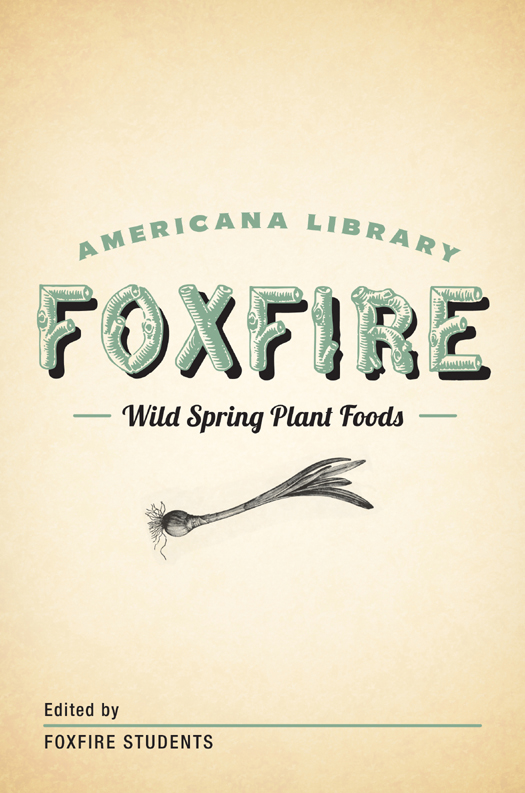
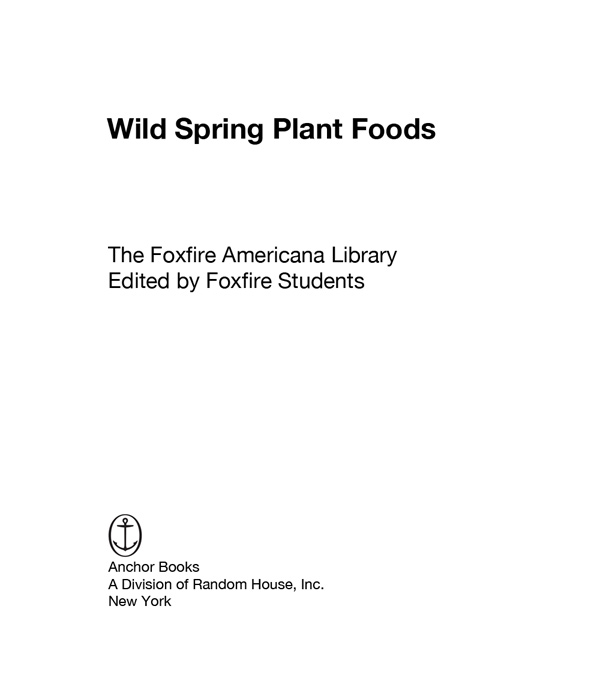
ANCHOR BOOKS EDITION, SEPTEMBER 2011
Copyright 1973 by the Foxfire Fund, Inc.
All rights reserved. Published in the United States by Anchor Books, a division of Random House, Inc., New York.
Anchor Books and colophon are registered trademarks of Random House, Inc.
This material originally appeared in slightly different form in Foxfire 2, 1973 by the Southern Highlands Literary Fund, Inc. and Brooks Eliot Wigginton. Reprinted by permission of Random House, Inc.
eISBN: 978-0-307-94826-7
v3.1
For almost half a century, high school students in the Foxfire program in Rabun County, Georgia, have collected oral histories of their elders from the southern Appalachian region in an attempt to preserve a part of the rapidly vanishing heritage and dialect. The Foxfire Fund, Inc., has brought that philosophy of simple living to millions of readers, starting with the bestselling success of The Foxfire Book in the early 1970s. Their series of fifteen books and counting has taught creative self-sufficiency and has preserved the stories, crafts, and customs of the unique Appalachian culture for future generations.
Traditionally, books in the Foxfire series have included a little something for everyone in each and every volume. For the first time ever, through the creation of The Foxfire Americana Library, this forty-five-year collection of knowledge has been organized by subject. Whether down-home recipes or simple tips for both your household and garden, each book holds a wealth of tried-and-true information, all passed down by unforgettable people with unforgettable voices.
T he forests and fields of the mountains are literally filled with edible leaves, berries, and roots. Many of these have been used by the mountain people for several generations. In pioneer days, the use of wild plants to supplement the daily diet was a necessity, and many of the plants used served as tonics or medicines as well. Nowadays, with the lure of modern food markets, the use of many of the wild plants is a matter of choice, rather than need. Many of our informants say, My mother, or my aunt, or my grandmother used that but we dont bother gathering it.
There is a revival of interest in the wild plant foods, for many who have migrated to the city are finding pleasure and good eating in returning to the country on occasion and gathering wild greens or berries. Most of the wild plants have a high vitamin and mineral content, and add greatly to the foods essential for good nutrition.
We began gathering information on this topic several years ago. Though it is not a complete handbook or guide to the woods by any means, it does reflect everything we have found so far; and everything included here has been verified and rechecked with our native informants (with the exception of those few recipes marked by an asterisk, which are recipes that came to us second-hand rather than directly from our mountain contacts).
In addition, we have enlisted for this chapter the invaluable aid of Marie Mellinger, a local botanist, who checked all our plant specimens, verified their botanical names and characteristics, tried almost every one of the recipes herself, and helped us compile all this into a chapter that would make some sense and that you might use yourselves. With her help, weve listed the plants according to their botanical order. Mrs. Mellinger also found Carol Ruckdeschel for us, a botanical illustrator, who provided us with the pen-and-ink drawings.
For those of you who intend to try to find and use some of these plants yourselves, we should emphasize that the plants named are those traditionally used here in southern Appalachia. Although they may well exist in your part of the country, you may need to consult a local plant guide to make sure. And we would also urge you to avoid plants that are becoming rare and on the verge of extinction in your areas. There will be no problem with the vast majority of thesedandelion, for examplebut in this age of asphalt and summer home developments, edible plants such as Indian cucumber, wild ginger, and wintergreen have suffered terribly.
And we must issue a word of caution. John Evelyn wrote, How cautious then ought sallet gatherers be, lest they gather leaves of any plant that do them ill. NEVER GATHER A PLANT UNLESS YOU ARE FAMILIAR WITH IT! Some plants are safe to use in small quantities, for example, sheep sorrel (Rumex) and wood sorrel (Oxalis), both rich in vitamin C. Overuse should be avoided because of their high content of oxalic acid. Sometimes one part of a plant will be safe to use, such as the stems of rhubarb, while the leaves must be avoided. Some plants are safe only after cooking.
One mountain man told us that people used to follow the cows in the spring of the year, to see what they would eat. This could be dangerous, for cows are notoriously stupid, and will eat the plants that cause milk-sickness, and such deadly things as wiited cherry leaves.
Most greens and salad plants used are in the mustard family and composite family. Most of the plants of the mustard family used for greens have a most characteristic mustardy smell and sharp pungent taste. Most fruits and berries are in the rose or heath family. Plants to be avoided are those of the parsnip family, for many resemble the deadly cow parsnip, or water hemlock. Someone, sometime, must have experimented, finding the edible plants by trial and possibly fatal error. Now there is no necessity for that. Descriptions, drawings, and photographs of the edible plants all help you to determine their identity.
There is almost nothing better after a long winter (and remember, most greens are best when young and tender) than a mess of dandelion, lambs quarters, or cress. Absolutely nothing equals a dish of wild strawberries freshly gathered in a sunny meadow, with all the goodness of sun and rain within their tart sweetness. Have fun in the gathering, and good eating!
After a long winter, spring was the time to refresh the spirit and tone up the system with a tonic. The mountain people used teas as beverages and as tonics. They would gather the roots or barks in the proper season, dry them, store them in a dry place, and use them as they wanted them. People used sugar, honey, or syrup to sweeten the teas. Common spring tonics were sassafras, spicebush, and sweet birch.
Lovey Kelso told us, We had to have sassafras tea, or spicewood, to tone up the blood in spring, but I never cared for either.
Sassafras (Sassafras albidum) (family Lauraceae)
(white sassafras, root beer tree, ague tree, saloop)
Sassafras is usually a small tree, growing in clumps, in old fields and at woods edge. It is one of the first trees to appear on cut-over lands. In the mountains, however, sassafras may grow to sixty feet tall. Twigs and the bark of young trees are bright green, older bark becomes crackled in appearance. Leaves are variable in shape, being oval, mitten-shaped, or three-divided. Leaves, twigs, and bark are all aromatic. The greenish-yellow, fragrant flowers appear in early spring and are followed by deep blue berries. The so-called red sassafras is identified by some botanists as Sassafras albidum variety molle, and has soft hairiness on the leaves and twigs. The recipes that follow can be used with either variety.
Font size:
Interval:
Bookmark:
Similar books «Wild Spring Plant Foods»
Look at similar books to Wild Spring Plant Foods. We have selected literature similar in name and meaning in the hope of providing readers with more options to find new, interesting, not yet read works.
Discussion, reviews of the book Wild Spring Plant Foods and just readers' own opinions. Leave your comments, write what you think about the work, its meaning or the main characters. Specify what exactly you liked and what you didn't like, and why you think so.

